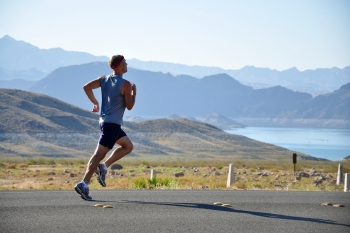Daily hopping can improve running economy
If you're runner, one thing you can improve to maximise your performance is your running economy. Running economy refers to the efficiency with which a runner utilises oxygen and energy while maintaining a specific running speed. It is a measure of how effectively the body utilises oxygen to produce forward motion. A runner with good running economy can maintain a desired pace while expending less energy compared to a runner with poor running economy.

If you're runner, one thing you can improve to maximise your performance is your running economy. Running economy refers to the efficiency with which a runner utilises oxygen and energy while maintaining a specific running speed. It is a measure of how effectively the body utilises oxygen to produce forward motion. A runner with good running economy can maintain a desired pace while expending less energy compared to a runner with poor running economy.
Factors that can influence running economy include biomechanics, muscular strength and coordination, aerobic capacity, and neuromuscular efficiency. Efficient running mechanics, such as proper posture, stride length, and cadence, contribute to better running economy. Strong and coordinated muscles, particularly those in the lower body, can improve energy transfer and reduce unnecessary movement. Additionally, having a high aerobic capacity and well-developed cardiovascular system allows for efficient oxygen delivery to the working muscles.
Improving running economy can lead to several benefits, including enhanced endurance, increased running speed, and reduced risk of fatigue and injury. Training strategies aimed at improving running economy often include a combination of aerobic exercises, strength training, plyometrics, and technique drills. Regular practice, gradual progression, and consistency in training can help optimise running economy over time.
It's important to note that individual factors, such as genetics, body composition, and training history, can influence running economy. However, plyometric exercises, such as hopping, can be beneficial for runners. These exercises involve explosive movements that develop power, strength, and coordination.
Hopping exercises specifically target the muscles and tendons involved in running, improving their elasticity and responsiveness. By performing daily hopping drills, runners can enhance their lower-body strength, increase their ability to store and release energy with each stride, and improve overall running economy.
In a study of 34 amateur runners, running economy and respiratory exchange ratio (substrate utilization) was improved at moderate to high speeds following 6 weeks of double-leg hopping. The number of hops (reps and sets) for each session (5 minutes) gradually increased over the 6-week period (week 1: 5 sets of 10 hops; week 6: 15 sets of 10 hops). The authors hypothesised that jumping drills can increase Achilles tendon stiffness. Superior running performance is associated with greater Achilles tendon stiffness and moment arms.
So what does this mean? Our advice to all keen runners is to incorporate 5 minutes of skipping or plyometric drills within your twice weekly strength training routine, or as a part of your daily running warm up routine. It's worth noting that incorporating hopping exercises into a well-rounded training program that includes a mix of strength training, cardiovascular workouts, and proper rest is essential for optimising running performance and minimising the risk of injury. For more information, contact us!
Reference: https://www.ncbi.nlm.nih.gov/pmc/articles/PMC10011548